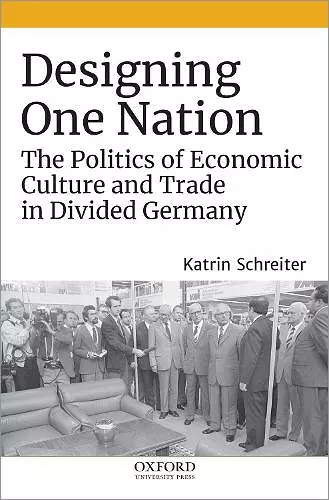Designing One Nation
The Politics of Economic Culture and Trade in Divided Germany
Format:Hardback
Publisher:Oxford University Press Inc
Published:5th Jan '21
Currently unavailable, and unfortunately no date known when it will be back

This is an open access title available under the terms of a CC BY-NC-ND 4.0 International License. It is free to read at Oxford Scholarship Online and offered as a free PDF download from OUP and selected open access locations, thanks to a generous grant from the Andrew W. Mellon Foundation. The histories of East and West Germany traditionally emphasize the Cold War rivalries between the communist and capitalist nations. Yet, even as the countries diverged in their political directions, they had to create new ways of working together economically. In Designing One Nation, Katrin Schreiter examines the material culture of increasing economic contacts in divided Germany from the 1940s until the 1990s. Trade events, such as fairs and product shows, became one of the few venues for sustained links and knowledge between the two countries after the building of the Berlin Wall. Schreiter uses industrial design, epitomized by the furniture industry, to show how a network of politicians, entrepreneurs, and cultural brokers attempted to nationally re-inscribe their production cultures, define a postwar German identity, and regain economic stability and political influence in postwar Europe. What started as a competition for ideological superiority between East and West Germany quickly turned into a shared, politically legitimizing quest for an untainted post-fascist modernity. This work follows products from the drawing board into the homes of ordinary Germans to offer insights into how converging visions of German industrial modernity created shared expectations about economic progress and living standards. Schreiter reveals how intra-German and European trade policies drove the creation of products and generated a certain convergence of East and West German taste by the 1980s. Drawing on a wide range of sources from governments, furniture firms, industrial design councils, home lifestyle magazines, and design exhibitions, Designing One Nation argues that an economic culture linked the two Germanies even before reunification in 1990.
Schreiter does an impressive job weaving together the East and West German strands of her multilayered narrative, seamlessly integrating material from various archives, published sources, and oral history interviews. She is at her best when dealing with economic and political history, about which she writes cogently and authoritatively.... Designing One Nation is an impressive and informative book. By offering exciting new perspectives with significant explanatory potential, it makes a valuable original contribution to the literature on Cold War German history. * Katharina Pfützner, American Historical Review *
Designing One Nation is an important book that, by using design as a lens, offers a fresh perspective on the German Question. * Katarzyna Jez:&owska, Journal of Contemporary History *
Katrin Schreiter offers a multifaceted analysis of the interconnected history of furniture design, production and consumption. She never glosses over differences or tries to smooth them over in favour of a coherent narrative. Instead, she shows how difficult and frustrating the relations could be. It becomes clear that a seemingly unpolitical area such as industrial design was highly politicized and ideologically charged during the Cold War * Sina Fabian, German History *
Simply put, this book is outstanding. With this first-rate monograph, Katrin Schreiter has established herself as a leading authority on the interconnectedness of the two Cold War Germanys. * Jason Johnson, Trinity University, New England Journal of History *
Katrin Schreiter makes brilliant use of material culture and industrial design to help us understand the Cold War in a new way. Unlike most studies, her work points to the essential connectedness of West and East Germany. Her work is also a powerful argument for the centrality of material culture, consumption, and industrial design to politics and even foreign policy. * Eli Rubin, Western Michigan University *
This is a landmark study in the history of postwar German material culture. Schreiter gives us a tangible, even tactile sense of how East and West Germany championed differing aesthetic values while collaborating surreptitiously in the manufacture of household goods. Design history and international relations intersect here in a thoroughly original and carefully researched analysis. * William Glenn Gray, Germany's Cold War *
Through its new look at furniture design, this book contributes critically to a growing body of scholarship re-examining the Cold War Germanys as economically and culturally intertwined. Artfully moving between East and West German cases and embedding individual living rooms in the complex nexus of international trade, Schreiter has crafted an integrated history of aesthetic and institutional commonalities across the Iron Curtain. She offers significant insights into how diplomacy and politics of trade between the two Germanys influenced and were shaped by European integration, thereby suggesting Germany's halves converged culturally even before national reunification. * Katherine Pence, Baruch College, City University of New York *
This book draws on a rich source base and presents Cold War production and consumption as a complex story of hostility, good will, and practical accommodation. * Jonathan Wiesen, University of Alabama at Birmingham, Journal of Modern History *
ISBN: 9780190877279
Dimensions: 160mm x 239mm x 25mm
Weight: 590g
306 pages